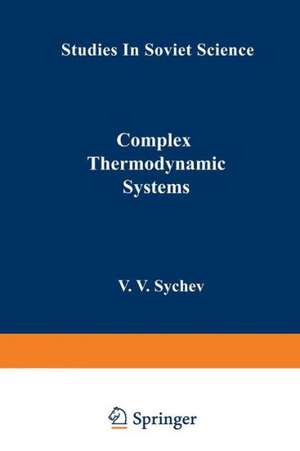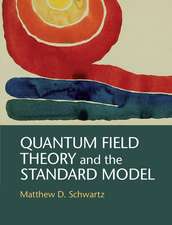Complex Thermodynamic Systems: Studies in Soviet Science
Autor V. V. Sycheven Limba Engleză Paperback – 24 apr 2012
Din seria Studies in Soviet Science
-
 Preț: 394.29 lei
Preț: 394.29 lei -
 Preț: 381.59 lei
Preț: 381.59 lei -
 Preț: 385.84 lei
Preț: 385.84 lei -
 Preț: 390.25 lei
Preț: 390.25 lei -
 Preț: 401.61 lei
Preț: 401.61 lei -
 Preț: 382.57 lei
Preț: 382.57 lei -
 Preț: 397.16 lei
Preț: 397.16 lei -
 Preț: 387.75 lei
Preț: 387.75 lei - 5%
 Preț: 362.88 lei
Preț: 362.88 lei -
 Preț: 387.75 lei
Preț: 387.75 lei - 5%
 Preț: 360.70 lei
Preț: 360.70 lei -
 Preț: 389.88 lei
Preț: 389.88 lei -
 Preț: 397.16 lei
Preț: 397.16 lei -
 Preț: 386.81 lei
Preț: 386.81 lei - 5%
 Preț: 366.56 lei
Preț: 366.56 lei - 5%
 Preț: 717.73 lei
Preț: 717.73 lei -
 Preț: 389.49 lei
Preț: 389.49 lei - 18%
 Preț: 726.06 lei
Preț: 726.06 lei - 15%
 Preț: 635.65 lei
Preț: 635.65 lei -
 Preț: 380.45 lei
Preț: 380.45 lei - 5%
 Preț: 363.44 lei
Preț: 363.44 lei - 15%
 Preț: 637.93 lei
Preț: 637.93 lei -
 Preț: 387.96 lei
Preț: 387.96 lei
Preț: 385.47 lei
Nou
Puncte Express: 578
Preț estimativ în valută:
73.76€ • 77.22$ • 61.03£
73.76€ • 77.22$ • 61.03£
Carte tipărită la comandă
Livrare economică 07-21 aprilie
Preluare comenzi: 021 569.72.76
Specificații
ISBN-13: 9781468416077
ISBN-10: 1468416073
Pagini: 260
Ilustrații: XII, 242 p.
Dimensiuni: 152 x 229 x 14 mm
Greutate: 0.35 kg
Ediția:Softcover reprint of the original 1st ed. 1973
Editura: Springer Us
Colecția Springer
Seria Studies in Soviet Science
Locul publicării:New York, NY, United States
ISBN-10: 1468416073
Pagini: 260
Ilustrații: XII, 242 p.
Dimensiuni: 152 x 229 x 14 mm
Greutate: 0.35 kg
Ediția:Softcover reprint of the original 1st ed. 1973
Editura: Springer Us
Colecția Springer
Seria Studies in Soviet Science
Locul publicării:New York, NY, United States
Public țintă
ResearchCuprins
1 Introduction.- 1.1. The Equations of the First and Second Laws of Thermodynamics.- 1.2. Work.- 1.3. Heat Capacities.- 1.4. The Differential Equations of Thermodynamics.- 2 Equilibrium Thermodynamic Systems Which Undergo Other Forms of Work in Addition to Work of Expansion.- 2.1. Criteria for Equilibrium in Thermodynamic Systems.- 2.2. The Chemical Potential.- 2.3. Equilibrium Conditions in an Isolated Homogeneous System.- 2.4. The Conditions for Phase Equilibrium.- 2.5. The Maxwell Equations.- 3 Magnets.- 3.1. Introduction.- 3.2. Basic Thermodynamic Relations for Magnets.- 3.3. The Heat Capacities of a Magnet.- 3.4. Thermodynamic Processes in Magnets.- 3.5. The Magnetocaloric, Magnetostrictive, and Magnetoelastic Effects.- 3.6. Adiabatic Demagnetization.- 4 Insulators.- 4.1. Introduction.- 4.2. The Basic Thermodynamic Relations for Insulators.- 4.3. The Heat Capacities of an Insulator.- 4.4. Thermodynamic Processes in Insulators.- 4.5. The Piezoelectric, Electrostriction, Electrocaloric, and Pyroelectric Effects.- 5 Superconductivity.- 5.1. Introduction.- 5.2. Thermodynamics of the Transition from the Superconducting State to the Normal State.- 5.3. The Phase Diagram of a Superconductor.- 5.4. The Heat Capacity in the Superconducting and Normal Phases — Rutgers Formula.- 5.5. Magnetostriction of a Superconductor.- 6 Surface Phenomena.- 6.1. Some Basic Properties of Surfaces Separating Phases.- 6.2. Surface Tension.- 6.3. Basic Thermodynamic Relations for Surfaces.- 6.4. The Effect of Surface Phenomena on the Thermodynamic Properties of a System.- 6.5. Phase Equilibrium Conditions Taking Account of the Properties of the Phase Separation Surface.- 6.6. Capillarity.- 7 Gases and Liquids in a Gravitational Field.- 7.1. Basic Thermodynamic Relations for a System in aGravitational Field.- 7.2. Distribution of Pressure and Other Quantities with Height of a Gas or Liquid Column.- 7.3. Entropy of a System in a Gravitational Field.- 7.4. Adiabatic Flow in a Gravitational Field.- 7.5. Thermodynamics of the Atmosphere.- 8 Liquids in the Weightless State.- 8.1. Features of the Behavior of Two-Phase Systems in the Weightless State.- 8.2. Possibility That One of the Phases May Lose Contact with the Walls of the Vessel.- 8.3. Stable Equilibrium States of a Two-Phase System.- 9 Radiation.- 9.1. Radiation in a Cavity as a Thermodynamic System.- 9.2. The Equations of State for a Photon Gas.- 9.3. Entropy and Chemical Potential of the Photon Gas.- 9.4. Thermodynamic Processes in a Photon Gas Heat Capacity.- 10 Elasticity of Solids.- 10.1. Basic Thermodynamic Relations for Solids.- 10.2. The Equation of State for an Elastically Deformed Rod.- 10.3. The Caloric Properties of an Elastically Deformed Rod.- 10.4. Adiabatic and Isothermal Deformation of a Rod.- Supplementary Readings.














